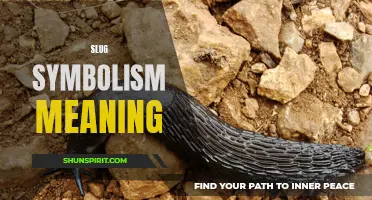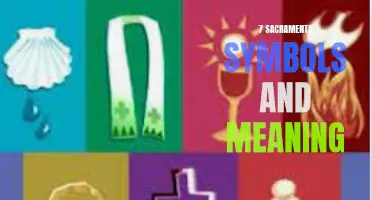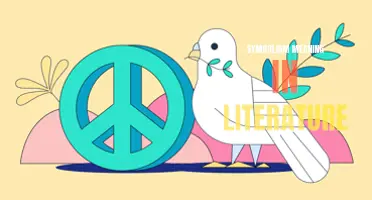
Nordic symbols are the ancient and mystical runes and motifs that have long held great significance to the people of the Nordic region. From the powerful hammer of Thor to the intricate knots of the Valknut, these symbols not only serve as decorative designs but also carry deep meanings and convey powerful messages. These symbols have been passed down through generations, embodying the rich history, mythology, and spirituality of the Nordic culture. Exploring the world of Nordic symbols is like delving into a universe of hidden meanings and ancient wisdom, providing a fascinating glimpse into the beliefs and traditions of these renowned seafaring and adventurous people. Whether you are fascinated by mythology, craving for spiritual enlightenment, or simply drawn to their captivating aesthetics, Nordic symbols are sure to captivate your imagination and inspire you to delve deeper into their enchanting meanings.
What You'll Learn
- What are some common Nordic symbols and their meanings?
- How have Nordic symbols evolved in meaning over time?
- Are there any specific colors or patterns associated with Nordic symbols?
- Do different Nordic countries have their own unique symbols and meanings?
- How are Nordic symbols incorporated into modern design and artwork?

What are some common Nordic symbols and their meanings?
The Nordic countries have a rich and fascinating history, and their cultures are filled with various symbols that hold profound meanings. These symbols are widely recognized and are often incorporated into art, jewelry, clothing, and other forms of expression. Here are some of the most common Nordic symbols and their meanings:
- Valknut: The Valknut is a symbol consisting of three interlocking triangles. It is commonly associated with Odin, the chief god of Norse mythology. The Valknut is believed to symbolize Odin's power over life and death and is sometimes associated with the concept of reincarnation.
- Mjölnir: Mjölnir is the hammer of Thor, the god of thunder in Norse mythology. The symbol is often worn as a pendant or amulet and is believed to offer protection and bring strength to the wearer. Mjölnir is also associated with fertility and was worn to ensure a successful harvest.
- Vegvísir: The Vegvísir is a runic compass symbol that originated in Iceland. It is believed to guide the wearer through rough weather and unfamiliar territory, both in a literal and metaphorical sense. The Vegvísir is often depicted as a symbol of protection and is thought to bring luck and safe travels.
- Helm of Awe: The Helm of Awe, also known as Ægishjálmr, is a circular symbol with eight arms that resemble tridents or spikes. This symbol is believed to grant protection and induce fear in enemies. The Helm of Awe was often used by warriors before going into battle to instill courage and ward off evil.
- Yggdrasil: Yggdrasil, the Tree of Life, is a massive ash tree that connects the nine worlds of Norse mythology. It symbolizes the connection between different realms and the cyclical nature of life and death. Yggdrasil is often depicted with roots and branches extending into various realms, representing the interconnectedness of all things.
- Aegishjalmur: Aegishjalmur, also known as "The Helm of Terror," is a symbol commonly associated with Viking warriors. It is believed to provide protection and invincibility in battle. Aegishjalmur is often depicted as an eight-armed star or a series of interlocking triangles.
- Futhark Runes: The Futhark runes are an ancient alphabet used by Norse and Germanic tribes. Each rune has its own symbolic meaning and is believed to possess magical properties. The runes were often used for divination and communication with the gods.
These symbols are just a few examples of the rich Nordic symbolism that is deeply ingrained in the culture and history of the region. They are not only aesthetically pleasing but also carry deep meanings that evoke a sense of bravery, protection, guidance, and connection to the spiritual world. Whether used as tattoos, jewelry, or simply admired for their beauty, these symbols continue to be cherished and celebrated by people around the world.
Decoding the Hidden Symbolism: Unraveling the Meaning Behind Text Symbols
You may want to see also

How have Nordic symbols evolved in meaning over time?
Nordic symbols have a rich history and have evolved in their meaning and significance over time. From the ancient Norse runes to the modern-day use of Viking symbols, these symbols have come to represent a variety of ideas and values.
The Norse runes, which date back to the 2nd century, were originally a system of writing used by the Norse people. Each rune had a specific sound and meaning, and they were often used in magical and divinatory practices. Over time, however, the meaning of these runes began to shift and evolve. Today, many people associate them with the powerful and mystical nature of the Norse gods and the wisdom and knowledge they represent.
One of the most well-known Nordic symbols is the Valknut, also known as the "knot of the slain." This symbol consists of three interlocking triangles and has been found on ancient Viking artifacts and burial sites. While its original meaning is not entirely clear, it is commonly associated with Odin, the Allfather of Norse mythology, and can symbolize bravery, honor, and the connection between life and death.
Another significant Nordic symbol is the Mjölnir, the hammer of Thor. This symbol is widely recognized as a representation of strength, protection, and fertility. In Norse mythology, Thor used his hammer to protect the gods and humanity from the forces of evil. Today, the Mjölnir is often worn as a pendant or tattooed as a symbol of strength and resilience.
The Helm of Awe, also known as the Aegishjalmur, is another powerful Nordic symbol. It is often depicted as a circular array of eight radially symmetrical arms, each containing a simple line. This symbol was believed to bring protection and strength to the wearer and was often used in battle to instill fear in one's enemies. Today, it is often seen as a sign of personal power and inner strength.
The use of Nordic symbols has also evolved in contemporary popular culture. They are often used in various forms of art, jewelry, and tattoos, with each individual imbuing their own personal meaning into them. Some see them as a way to connect with their Nordic heritage, while others see them as a representation of certain aspects of their personality or beliefs.
In conclusion, Nordic symbols have evolved in meaning over time. From their original use as a writing system to their modern-day associations with strength, protection, and personal power, these symbols have remained an important aspect of Norse culture and mythology. Their continued use in contemporary popular culture ensures that their meaning will continue to evolve and resonate with different individuals in unique ways.
Decoding the Symbolism: Unveiling the Hidden Meanings Behind Hollywood's Symbols
You may want to see also

Are there any specific colors or patterns associated with Nordic symbols?
Nordic symbols have a rich history and are deeply rooted in the traditions and beliefs of the Nordic countries. These symbols often represent various aspects of their culture, including their mythology, religion, and history. While there may not be any specific colors or patterns that are universally associated with Nordic symbols, there are some common themes and visual elements that are often seen in their depiction.
One of the most well-known Nordic symbols is the Viking rune, which was used as a writing system by the ancient Norse people. These runes were often inscribed on stone, wood, or metal, and their designs were simple and angular. The colors associated with Viking runes are typically neutral and earthy tones, such as brown, gray, or black. This is perhaps to reflect the natural materials on which they were often found.
Another widely recognized Nordic symbol is the Valknut, which consists of three interlocking triangles. The Valknut is associated with the Norse god Odin and is believed to represent his power and connection to the afterlife. When depicted visually, the Valknut is often shown in black or dark gray against a lighter background.
The Norse mythology also features many animals and creatures, and these often appear in Nordic symbols as well. The mythological creatures such as dragons, wolves, and serpents are commonly depicted with bold, vibrant colors. These colors are often associated with strength, power, and magic. For example, the dragon, which is a symbol of protection and strength, is often depicted in shades of red and gold.
In terms of patterns, Nordic symbols commonly feature repeating geometric shapes and intricate knotwork. These patterns can be seen in various forms of Norse art, from wood carvings to jewelry. The intricate knotwork is known as "Viking design" and is characterized by interlocking knots and weaves. These patterns are often associated with the concept of eternity and the interconnectedness of all things in the Norse belief system.
In conclusion, while there may not be any specific colors or patterns that are universally associated with Nordic symbols, there are some common themes and visual elements often seen in their depiction. The colors associated with Nordic symbols often reflect the natural materials on which they were found, while patterns often feature repeating geometric shapes and intricate knotwork. This rich visual language adds depth and meaning to the Nordic symbols, allowing them to convey the cultural heritage and beliefs of the Nordic countries.
Understanding the Symbols on DraftKings: An Overview of Their Meaning
You may want to see also

Do different Nordic countries have their own unique symbols and meanings?
The Nordic countries, including Finland, Sweden, Norway, Denmark, and Iceland, have a rich history and culture that is often characterized by distinct symbols and meanings. From ancient myths and folklore to national emblems and traditions, each country within the region has its own unique set of symbols that hold great significance.
One of the most well-known symbols throughout the Nordic countries is the Viking symbol. Vikings were fierce warriors who lived during the Middle Ages and played a significant role in shaping the history and culture of the region. The Viking symbol, which often includes rune stones, ships, and axes, represents strength, power, and adventure. While the Vikings are most strongly associated with Denmark, their influence spread throughout the entire Nordic region.
In Finland, the national symbol is the Finnish lion. This lion, which is often depicted with a sword, represents bravery, courage, and Finnish national identity. The Finnish lion can be found on the national coat of arms and is a widely recognized symbol throughout Finland.
In Sweden, one of the most iconic symbols is the Dala horse. These hand-carved wooden horses, painted in bright colors and traditional patterns, are a popular souvenir and symbol of Swedish handicrafts. The Dala horse represents Swedish craftsmanship and artistic traditions, and is highly prized both within Sweden and internationally.
Norway is known for its stunning natural landscapes, particularly its fjords. The Norwegian flag, with its red background, white cross, and blue Scandinavian cross, represents the country's connection to the sea and its long maritime history. The blue cross is said to symbolize the importance of Christianity in Norwegian culture, while the red background is associated with bravery and patriotism.
In Iceland, the national symbol is the Icelandic flag. This flag, which features a red cross on a white background, represents both Iceland's connection to the Nordic region and its rich Viking heritage. The flag is a powerful symbol of national pride and independence, and is often displayed during national holidays and celebrations.
While each Nordic country has its own unique symbols and meanings, there are also several symbols and traditions that are shared across the region. For example, the Northern Lights, also known as the Aurora Borealis, are a natural phenomenon that can be seen in all of the Nordic countries. This dazzling display of lights in the sky is associated with magic, mystery, and the supernatural, and is a symbol of the beauty and power of nature.
Another shared symbol is the Christmas gnome, or "nisse." These mischievous little creatures are believed to live in the barns and homes of Nordic households and are associated with good luck and protection. The tradition of the nisse is celebrated in all Nordic countries, with variations in folklore and appearance.
In conclusion, the Nordic countries indeed have their own unique symbols and meanings. From Viking symbols representing strength and adventure, to national emblems representing bravery and national identity, each country within the region has its own distinct set of symbols that hold great significance. Additionally, there are shared symbols and traditions that are celebrated across the Nordic region, connecting the countries through their rich history and cultural heritage.
The Symbolic Meaning of the Number 8 and Its Powerful Significance
You may want to see also

How are Nordic symbols incorporated into modern design and artwork?
Nordic symbols have a rich and historical significance in the culture and traditions of the Nordic countries. From the ancient Vikings to modern-day Scandinavia, these symbols continue to be a source of inspiration for artists and designers. In modern design and artwork, Nordic symbols are often incorporated to pay homage to the region's history, mythology, and natural beauty.
One of the most common Nordic symbols seen in design and artwork is the Valknut, also known as the "knot of the slain warrior." This symbol is made up of three interconnected triangles and is associated with Odin, the chief deity in Norse mythology. The Valknut is often used to represent bravery, strength, and the connection between the living and the dead. In modern designs, the Valknut is commonly found in jewelry, tattoos, and decor to evoke a sense of Norse heritage and mythology.
Another popular Nordic symbol is the Vegvisir, often referred to as the "Icelandic compass." This symbol is believed to help guide travelers through rough weather and difficult conditions. The Vegvisir is often incorporated into tattoos and artwork as a reminder of one's personal journey and the ability to navigate through life's challenges.
In addition to these specific symbols, Nordic design often incorporates other elements from nature, such as the Scandinavian forest, mountains, and wildlife. These natural elements are often depicted in minimalist designs that capture the simplicity and beauty of the Nordic landscape. This style of design, known as "Nordic minimalism," has gained popularity in recent years for its clean lines, neutral colors, and emphasis on functionality.
Nordic symbols and design are not limited to traditional art forms. They can also be found in contemporary graphic design, interior decor, and even fashion. Many designers and artists draw inspiration from Nordic symbols to create unique and eye-catching patterns, prints, and textiles. The combination of ancient symbolism with modern aesthetics creates a harmonious blend of the old and the new.
Furthermore, Nordic symbols are often used in branding and logo design to evoke a sense of authenticity and connection to the region's heritage. Companies that want to convey a sense of Scandinavian quality and craftsmanship often incorporate Nordic symbols into their logos and packaging designs.
Overall, the incorporation of Nordic symbols into modern design and artwork serves as a reminder of the rich cultural heritage of the Nordic countries. Whether it's through ancient symbols like the Valknut and Vegvisir or through the depiction of the natural landscape, Nordic symbols add depth, meaning, and a touch of history to contemporary designs.
Decoding the Hidden Meanings Behind Hollywood's Most Iconic Symbols
You may want to see also
Frequently asked questions
The Vegvisir symbol, also known as the "Runic Compass" or "Viking Compass," is a popular Nordic symbol that is believed to provide guidance and protection to its wearer. It is often associated with the concept of finding one's way through stormy and unfamiliar waters, both literally and metaphorically.
The Mjolnir symbol, also known as Thor's Hammer, is one of the most well-known and widely recognized Nordic symbols. It represents the power and protection of the Norse god Thor, who was known for his strength and ability to overcome obstacles. The hammer is also believed to be a symbol of fertility and blessing.
The Valknut symbol is a complex and intriguing symbol that is believed to represent various concepts in Norse mythology. It is often associated with Odin, the Allfather of the gods, and is believed to symbolize his power over life and death, as well as his ability to bind and connect different realms.
The Helm of Awe symbol, also known as the Ægishjálmur, is a powerful and protective symbol in Norse mythology. It is believed to grant its wearer great courage and strength, as well as offering protection against evil and danger. The symbol is often used as a talisman or amulet to ward off negative energies.
The Triple Horn of Odin symbol is often associated with the Norse god Odin and is believed to represent various concepts within Norse mythology. It is often interpreted as a symbol of abundance and prosperity, as well as a reminder of the interconnectedness of the three realms: Asgard (the realm of the gods), Midgard (the realm of humans), and Helheim (the realm of the dead).







